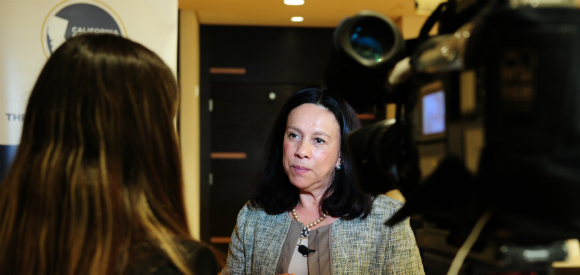
Antonia Hernández at the 2013 California Economic Summit in Los Angeles. (Photo Credit: Violeta Vaquiero)
In the weeks following the release of the California Economic Summit’s Roadmap to Shared Prosperity, the Summit’s co-chairs are outlining how they plan to use this new 5-year strategy for advancing a sustainable growth agenda across the state’s diverse regional economies.
Antonia Hernández, president and chief executive officer of the California Community Foundation, believes the Roadmap can help communities ensure economic growth doesn’t contribute to growing inequality and displacement. “I urge stakeholders to equip themselves with this Roadmap,” says Hernández, “and begin to enact change.”
The full Q&A with Hernández follows:
1. In your view, why does the state need a regions-driven agenda for sustainable growth and why is it important that the Roadmap’s proposals are grounded in the triple bottom line?
With its rich diversity of people and resources, California is on the precipice of new prosperity. But it can only achieve its greatest promise if the public and private sectors work together to address the state’s most vexing challenges. The Summit’s priorities of a triple bottom line—simultaneous growth in the economy, improvement in environmental quality and increased opportunity for all—is critical to ensuring the greatest impact for all of California’s residents. Given the vast economic and social diversity across our state’s communities, this plan does require regions-driven leadership to achieve sustainable growth and ultimately, a more equitable California.
2. The Roadmap emphasizes how much the state’s prosperity depends not just on slowing climate change and creating jobs—but on addressing problems of growing income disparity and rising poverty in every region and every city in California. What will it take for the Roadmap to be successful in increasing investment in education and infrastructure, improving workforce training programs, and expanding access to affordable housing?
 These ambitious goals cannot be achieved by one company, nonprofit organization or government agency alone. For the Roadmap to be successful, we will have to engage a variety of partners across sectors that are committed to implementing solutions that lead to systemic change.
These ambitious goals cannot be achieved by one company, nonprofit organization or government agency alone. For the Roadmap to be successful, we will have to engage a variety of partners across sectors that are committed to implementing solutions that lead to systemic change.
The California Community Foundation (CCF) has experienced the power of collaboration first-hand. For example, through a 2008 county-wide ballot measure that proposed a half-cent sales tax for improvements in transportation, Los Angeles voters agreed to invest $40 billion in one of the largest public works programs in U.S. history. The measure will double the size of our transit system, creating both opportunities and challenges for low income residents and neighborhoods. CCF is working with a network of regional public and private sector partners to ensure that this project is done equitably and without displacement. We believe increasing housing and job opportunities for all Angelenos near public transit will positively benefit local households, workers, employers and the region as a whole.
3. What role can philanthropic groups like the California Community Foundation play in these efforts to improve opportunity for all Californians?
Community Foundations are the local vehicle for expressing our collective yearning to live in a better place. At CCF, we aim to improve the quality of life of all Angelenos and create a more equitable region, where every resident has the opportunity to contribute to and participate in the great potential of Los Angeles. CCF is an advocate for change, a convener for diverse groups to come together and a steward entrusted with donors’ charitable funds.
But CCF is also one organization in a larger regional effort to expand resources to address vulnerabilities in Los Angeles County. Our initiatives are supported by strong networks across diverse sectors and among nonprofit groups, donors and other stakeholders. Through collaborative action we are redefining our role and our priorities to address some of the most intractable problems such as poverty, low educational attainment, the shortage of low-income housing and unemployment.
We must align our investments and initiatives to amplify our collective impact across California.
4. How do you think the Roadmap priorities can continue to be put into action? Do you see any immediate opportunities for Summit action teams and regional partners to work together on the Roadmap’s ideas?
The Roadmap provides a framework for regions to build upon over the next five years and beyond, but we are faced with numerous immediate challenges in every region. I urge stakeholders to equip themselves with this Roadmap and begin to enact change through statewide convenings with concrete action items that will lead us to measureable outcomes for California. Keeping in mind the triple bottom line will be key to our shared prosperity.

